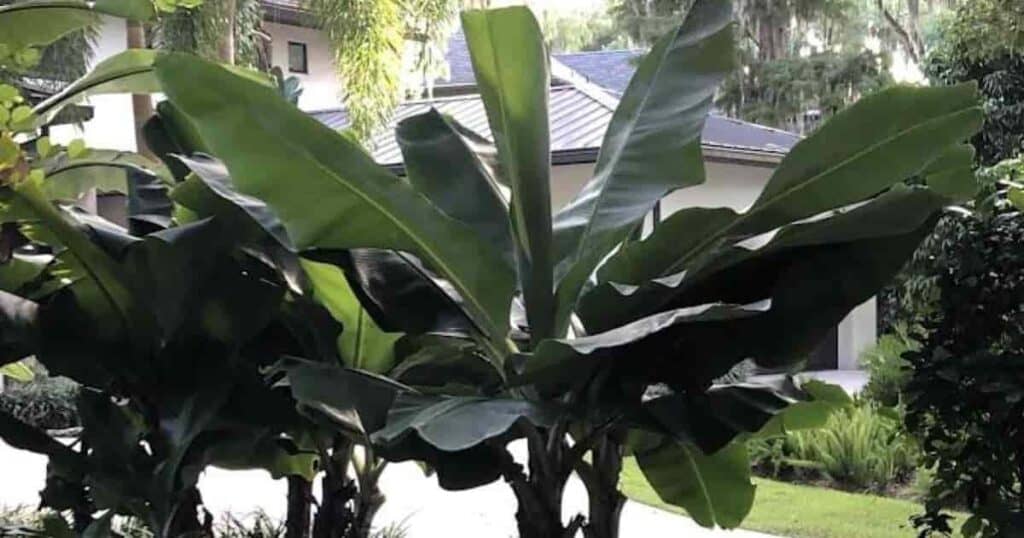Banana trees are some of the most popular plants which come to mind when you think about tropical plants.
Belonging to the genus Musa, these banana trees are incredibly rugged and may produce an abundance of sweet fruits.

A part of the Musaceae family, the genus Musa consists of more than 70 species of plantains and bananas.
The name of the genus is in honor of 1st century B.C. physician, Antonia Musa.
Interestingly enough, bananas plants are not trees at all. They are the world’s largest herb.
The main stem is the fruiting stem enrobed by large leaves. It’s the size of the plant which makes people assume it’s a tree.
Most cultivars of banana fruit grow best in warmer climates and hardiness zones 10 to 11.
However, there are cold-hardy banana trees as well.
For instance, one species called Musa basjoo may survive in Zone 5 when well-mulched.
Not only do banana plants add a tropical look and feel to your yard, but they also give fruits.
When provided the right growing conditions, you may end up cultivating many racks of sweet bananas (Ice Cream banana tree is sweet). Even a dwarf banana tree produces lots of fresh fruit.
Best Fertilizer for Banana Plants
To have good fruiting and healthy fruit trees, banana plants need full sun, organic matter, and lots of fertilizer as they are heavy feeders.
Banana fertilizer requirements need to include a high amount of NPK, i.e., Nitrogen, Phosphorus, and Potassium.

Whether you’re growing Cavendish bananas or Musa acuminate, the plant needs a lot of nourishment to produce a high number of bananas.
For this, you need to feed it regularly.
A balanced fertilizer formula makes an excellent banana fertilizer and can be used regularly.
This provides the plant with a sufficient amount of all the necessary micro and secondary nutrients needed.
The plant grows from a central corm or rhizome.

This means the parent plant dies after fruiting and young plant offspring, sometimes called Keiki, takes its place.
This helps the plant grow in small groves and make the most of the nutrients.
Use a high potassium fertilizer once a month in the growing season.
This is very important as Potassium is crucial to the plant’s health.
Details on Growing –> Tropical Bananas
When and How to Fertilize Banana Species
With heavy feeding needs, banana plants need a lot of organic matter to thrive and be productive.
NOTE: It is always good to have a soil test done before adding any fertilizer to plants.

If you have mature banana plants on your hands, use one and a half pounds of 8-10-10 NPK fertilizer.
For bananas in containers growing in potting soil or dwarf banana tree plants, cut down the amount by half.
Apply fertilizer every 3 months.
Remove enough soil from around the plant to hold the amount of fertilizer you will be feeding.
Water the plant over the fertilizer so it dissolves slowly and releases the nutrients into the soil.
Liquid Feeding is an Option
There is another way to feed a banana plant. Using a water-soluble formula, dissolve a lighter application of the fertilizer in water whenever you irrigate.

- This should be repeated when the soil dries out to about ½” inch.
- The method is different when using high potassium or high nitrogen fertilizer.
- Feed the plant with a high nitrogen fertilizer once a month during the growing season.
- Once the plant starts flowering, switch to a high potassium formula.
- This is essential for healthy fruits.
- Halt fertilizing when the plant begins to fruit or when the soil has a pH of 6.0.
- Paying close attention to potassium levels is crucial.
- It is an essential nutrient and encourages a good growth rate.
NOTE: Many staghorn fern growers use banana peels as fertilizer on their plants.
Signs of Potassium Deficiency
If you notice the following, you need to add potassium to the soil:
- Small, broken or crumpled leaves
- Leaf splitting
- Leaves falling down
- Yellow or orange leaves
- Small banana bunches

Similarly, nitrogen is also needed for a vegetative leaf growth with a healthy green color.
The amount of nitrogen in the soil impacts the size, weight, and number of bananas produced by the plant in the first six months.
Be vigilant about the levels of nutrients in the soil if you are growing banana trees.
Feed the plant regularly, especially during the growing season to make sure it fruits properly.
If you’re concerned about the plant despite feeding it enough, sample the soil and send it for a soil test evaluation.
This lets you take the proper steps to improve the overall growing conditions for your banana plants.